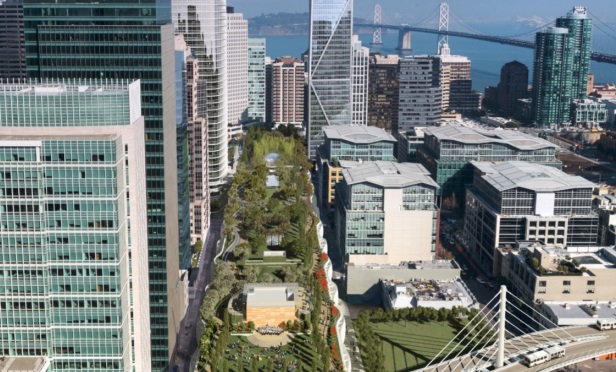 The new Salesforce Transit Center Park opened this past weekend atop the transit center.
The new Salesforce Transit Center Park opened this past weekend atop the transit center.
SAN FRANCISCO—During the course of San Francisco's history, urban parks have often served as the stimulus for neighborhood development. But how do you create a four-block park spanning 5.4 acres in a highly developed area of downtown? You build it on a roof.
And what a roof it is. The new Salesforce Transit Center Park opened this past weekend atop the transit center, providing green space in a downtown area surrounded by the high-rises of Trulia and BlackRock, and of course, Salesforce Tower, looming above. The park accomplishes multiple purposes not only for passengers but also for this newly developing area, as it increases the amount of open space in the neighborhood by 17%, according to the Transbay Joint Powers Authority.
One of the park's central features will be a Ned Kahn-designed 1,000-foot-long fountain with jets of water triggered by the movement of buses arriving and departing below. The walking path around the park's perimeter is approximately one-half mile long. This would allow a 5K race to be conducted in approximately six laps.
The park was designed by PWP Landscape Architecture. The design integrates mounded vegetated hills with domed architectural skylights that allow daylight into the Transit Center below.
Within the park, there are more than 600 trees and 12 smaller gardens keyed to a variety of plant life and environmental conditions, including Chilean, Mediterranean and South African gardens; palm and grass gardens; as well as gardens keyed to wetlands and environments typical of the Bay Area. The park is conceived to be a significant teaching tool, and its environments will be extensively labeled to allow for both formal and informal educational opportunities.
Transbay Joint Powers Authority hired Biederman Redevelopment Ventures/BRV to operate, manage and activate the park with year-round events and activities that will be free to the public. BRV is an urban planning and redevelopment company that provides consulting on parks, public spaces and neighborhood streetscapes in 26 states. BRV is part of a management team led by commercial real estate developer Lincoln Property Company.
“I've been hearing parents explain to 10-year-olds what we are doing here,” Dan Biederman, urban planning and redevelopment consultant, and the president of Biederman Redevelopment Ventures, told GlobeSt.com during the open house festivities. “This is the most elaborate planting scheme I've ever seen a public system do.”
The park will have more than a dozen entry points, potentially including bridges to surrounding buildings. Features range from a music amphitheater for up to 1,000 people, a restaurant, a cafe and a children's playground.
According to Biederman, typical BRV park programming being considered for the park includes yoga, exercise classes, cultural events, nighttime movies, chess, reading rooms, art shows, children's programming, bird watching and concerts. There will be at least seven fitness classes per week, including yoga.
Passive uses such as reading, picnicking or simply taking a break for lunch will be encouraged in numerous quiet areas. In fact, GlobeSt.com learns that there are currently 300 moveable chairs within the park and more are set to arrive, along with tables.
Biederman and BRV have considerable experience in aerial park development. BRV is currently involved in programming Toronto's CIBC Square Park, a 1-acre elevated park connecting the two buildings over a rail corridor adjacent to Union Station. And, BRV was a lead consultant in the planning, development and operation of Klyde Warren Park in Dallas, built atop a downtown freeway, uniting the city that had previously been divided by the roadway.
“This is a stronger opening than expected,” Biederman tells GlobeSt.com. “There are more people at this opening than for Klyde Warren Park and Bryant Park.”
Many of the live events and outdoor programming featured at both New York City's Bryant Park and Klyde Warren Park will be introduced at Salesforce Park.
Biederman gained national prominence when he privatized and transformed Bryant Park from a neglected midtown Manhattan space into one of the most well-known parks in the country. Bryant Park's revival created a real estate boom in the area surrounding the park, increasing the value of property and generating $33 million in additional real estate taxes for the city. Biederman thinks Salesforce Park could have a similar positive economic impact in San Francisco.
“Our vision of the rooftop park at the Salesforce Transit Center is an elevated urban oasis that offers the visitor experiences unlike any other public space in San Francisco,” says Biederman. “We aim to make the park an asset for the entire downtown and South of Market community, as well as a destination for people throughout the Bay Area.”
Construction of the project began in 2010 after demolition of the former Transbay Terminal at First and Mission streets, a once-remote site in 1938 when it was constructed. The project was necessitated by the 1989 Loma Prieta earthquake, which damaged the original Transbay Terminal.
The Salesforce Transit Center replaces the old terminal with a regional transit station that will connect eight Bay Area counties and the state through 11 transit systems. Salesforce agreed to a $110 million 25-year sponsorship of the terminal last July to help fund the center's operation, maintenance and security.
© Touchpoint Markets, All Rights Reserved. Request academic re-use from www.copyright.com. All other uses, submit a request to [email protected]. For more inforrmation visit Asset & Logo Licensing.







